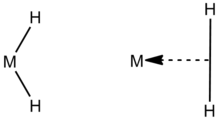Borderline hydrides
This article possibly contains original research. (September 2013) |
Borderline hydrides typically refer to hydrides formed of hydrogen and elements of the periodic table in group 11 and group 12 and indium (In) and thallium (Tl).[citation needed] These compounds have properties intermediate between covalent hydrides and saline hydrides. Hydrides are chemical compounds that contain a metal and hydrogen acting as a negative ion.
Properties
[edit]Borderline hydrides exhibit bonding characteristics between ionic and covalent bond types. A specific example of a borderline hydride is CuH, copper hydride, that appears as a spongy reddish-brown substance is a moderate reducing agent. It will catalytically oxidize hypophosphorous acid to phosphorous acid at room temperature, and it gives off hydrogen gas when subjected to heat.[1] ZnH2 is also a solid at room temperature that breaks down at 90 °C, but even left alone decomposes over several days to zinc metal and hydrogen gas.[2] Hydrogen telluride (H2Te) and hydrogen selenide (H2Se) are both borderline hydrides of high volatility that produce strong, unpleasant odors.
Examples
[edit]- (CuH)n copper hydride
- (ZnH2)n zinc(II) hydride
- HgH2 mercury(II) hydride
- TlH3 thallium hydride
Synthesis
[edit]Borderline hydrides are most commonly formed via the acidification or reduction of metal salts. For instance, copper hydride is formed by reacting copper sulfate and hypophosphorous acid at about 70 °C, forming a yellow precipitate that soon turns red-brown.[3] Zinc hydride, ZnH2, can be formed by the reduction of either a zinc halide or dimethylzinc.

Alternative definition
[edit]
A more recent definition of borderline hydrides refers to hydrides that exist between classic and non-classic dihydrides. The classic form is the dihydride M(H)2 configuration, where the metal is bound to two free hydrogen atoms. The non-classic form contains two hydrogen atoms bound to a central metal atom with an η2-H2 hapticity, indicating that a single coordination point on the metal atom bonds to two contiguous atoms from another molecule, in this case H2.[4] A well-known example of this is from the first such molecule to be synthesized with a coordinated hydrogen ligand (dihydrogen complex): W(CO)3(PPri3)2(η2-H2).[5] Classic dihydrides containing the dihydride M-(H)2 ligands are typically found as a tautomer with the non-classical dihydrogen complexes containing a M-(η2-H2) group.
Borderline hydrides exist with a bond character somewhere between the classical and non-classical hydrides.[6] Those that are thermally unstable exhibit stretching frequencies νHH greater than 2150 cm-1 as a result of poor electron donation from the metal center. An electron dense metal center will yield hydride with a νHH less than 2060 cm-1, while anything between is considered to be in the borderline region. Kubas, et al. state that a stretching frequency of 2090 cm-1 is within the bounds of stable H2 complexes while 2060 cm-1 is right on the borderline between dihydrogen and dihydrides.[5]
References
[edit]- ^ Bartlett, Edwin J.; Merrill, Walter H. (1895). "Cupric Hydride" (PDF). American Chemical Journal. 17: 185–189.
- ^ A. E. Finholt; A. C. Bond, Jr.; H. I. Schlesinger (1947). "Lithium Aluminum Hydride, Aluminum Hydride and Lithium Gallium Hydride, and Some of their Applications in Organic and Inorganic Chemistry". Journal of the American Chemical Society. 69 (5): 1199–1203. doi:10.1021/ja01197a061.
- ^ Fownes, George; Henry Watts (1885). Fownes' Manual of Chemistry, Theoretical and Practical. Philadelphia, PA: Lea Brothers & Co. pp. 372–373. Retrieved 2010-10-19.
cuprous hydride.
- ^ Crabtree, Robert H.; et al. (April 1990). "Dihydrogen Complexes: Some Structural and Chemical Studies". Accounts of Chemical Research. 23 (4): 95–101. doi:10.1021/ar00172a001.
- ^ a b Kubas, Gregory J. (March 1988). "Molecular hydrogen complexes: coordination of a σ bond to transition metals". Accounts of Chemical Research. 21 (3): 120–128. doi:10.1021/ar00147a005.
- ^ Crabtree, Robert H.; et al. (January 1992). "Molecular hydrogen complexes: coordination of a σ bond to transition metals". Organometallics. 11 (1): 237–241. doi:10.1021/om00037a044.
